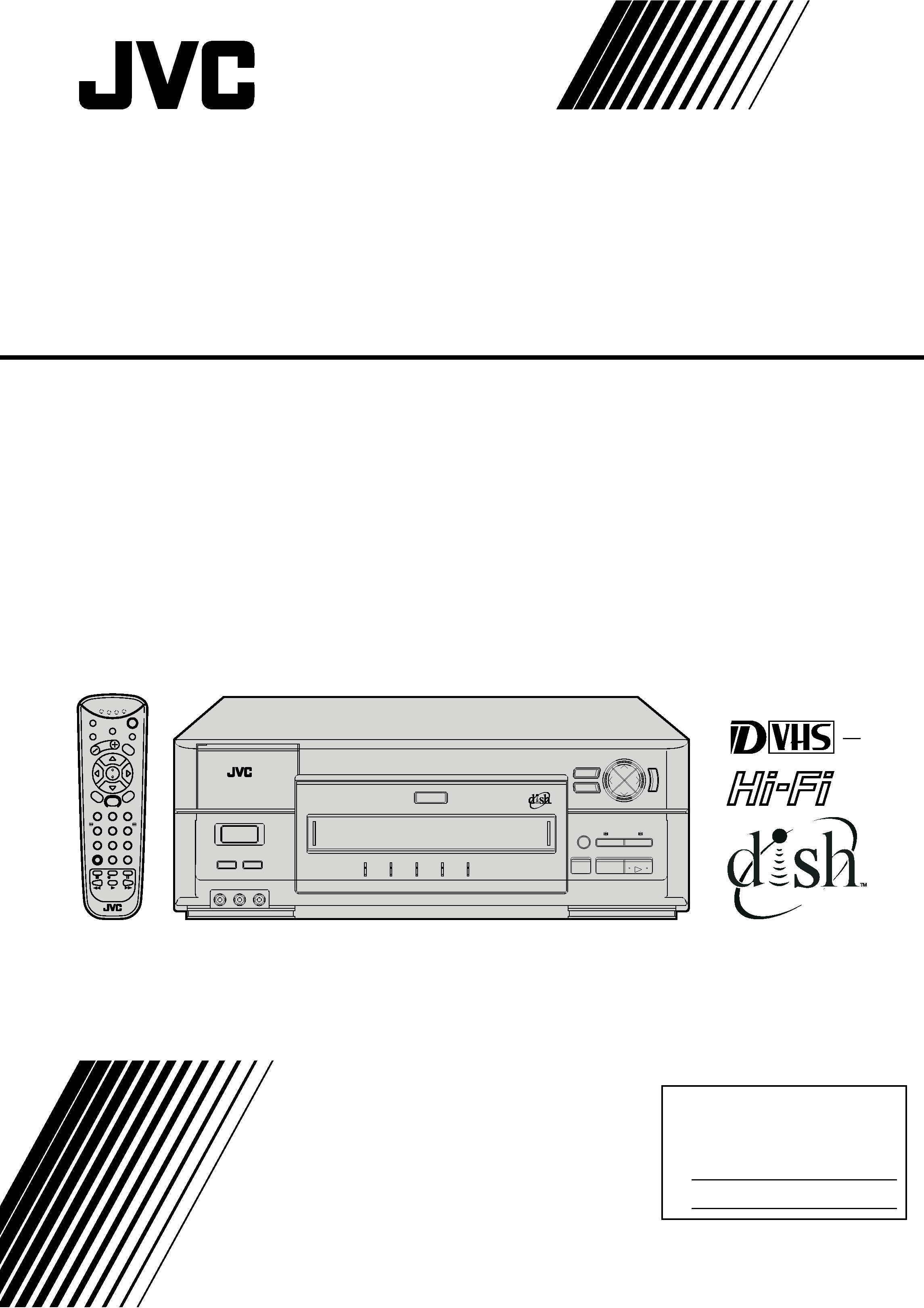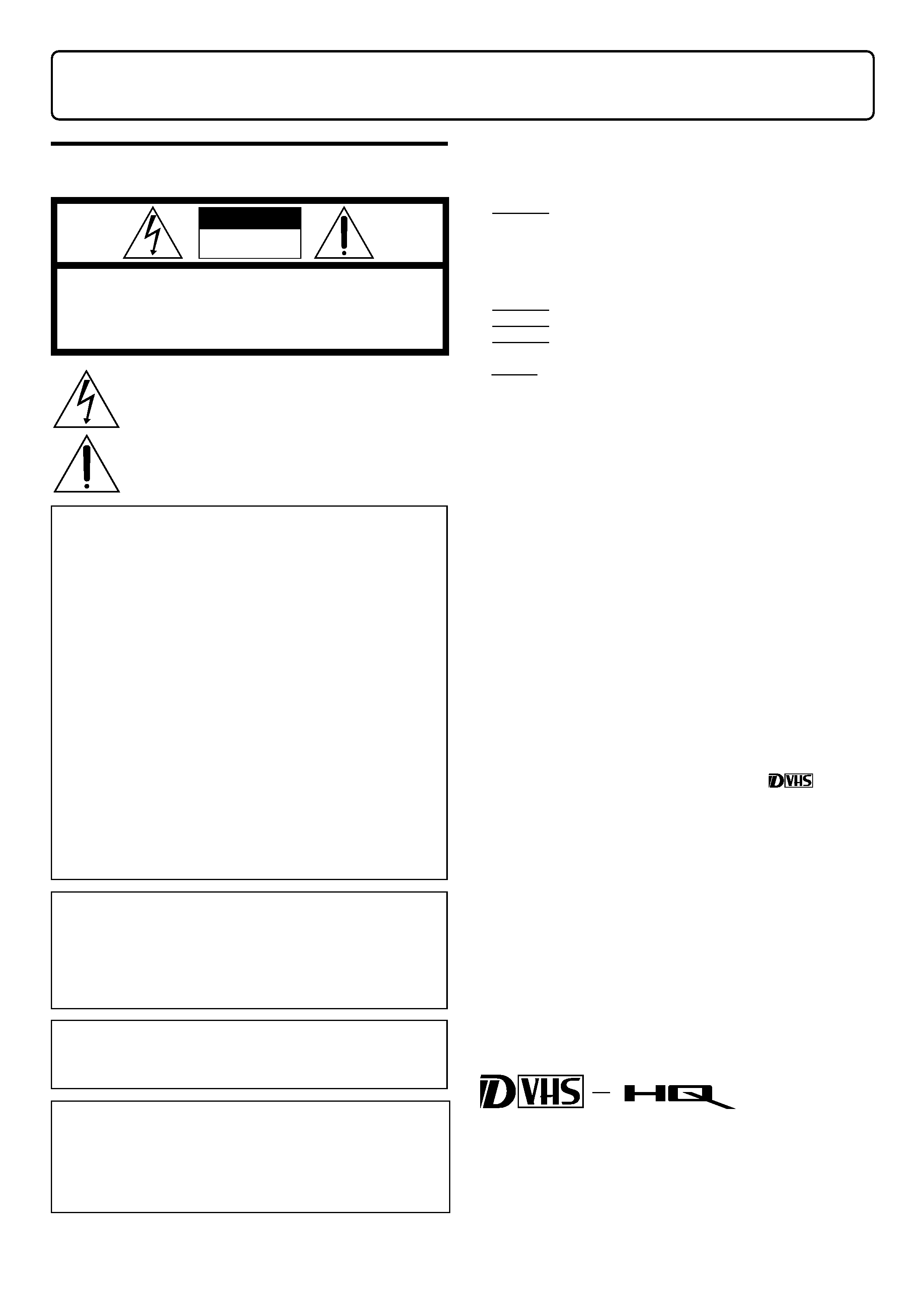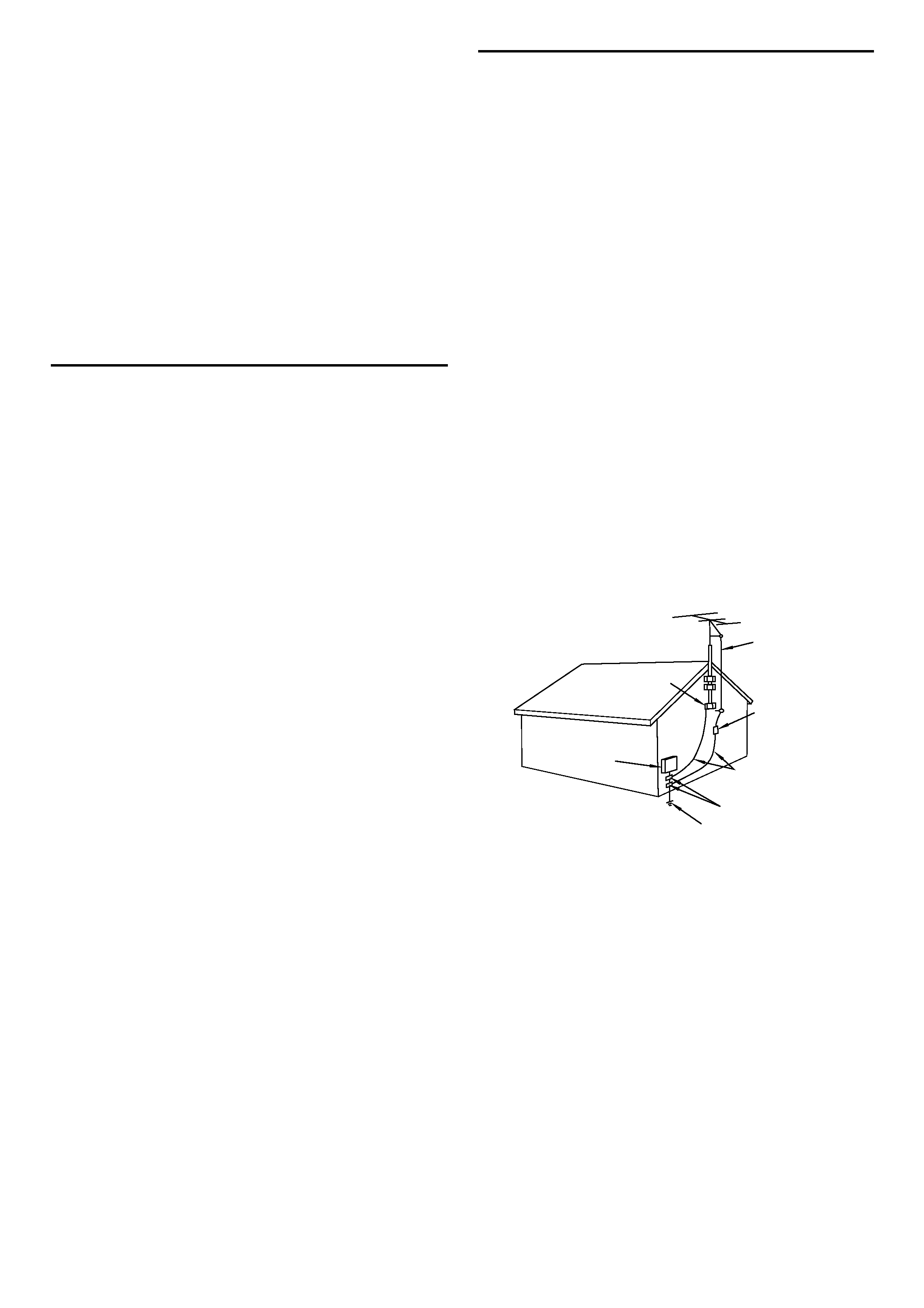
HM-DSR100U
HM-DSR100DU (with Antenna Kit)
HM-DSR100RU (without Antenna Kit)
D-VHS DIGITAL SATELLITE RECORDER
INSTRUCTIONS
LPT0002-0H9C
For Customer Use:
Enter below the Serial No. which is
located on the rear of cabinet. Retain
this information for future reference.
Model No.
Serial No.
2
6
q
5
3
PLAY
STOP
PAUSE
REC
POWER
REC
PAUSE
TIMER
EP
SELECT
MENU
CH
INFO
CH
REW
FF
POWER
TV/VCR
VIDEO (MONO)LAUDIOR
EJECT
D-VHS
TM
8
MTP
NTSC
VO
LUME
123
456
78
0
9
TV/VCR
MUTE
MENU
MODE
SELECT
VIEW
AUTO TRACK
POWER
GU
ID
E
IN
FO
CA
NC
EL
TM
INDEX
INDEX£
SKIP
SKIP
REW/BROWSE
ADDRESS
RECALL
COUNTER RESET
FF/BROWSE
REC
SAT
TV D-VHS AUX
B
R
O
W
S
E
T
H
E
M
E
TM

Dear Customer,
Thank you for purchasing the JVC D-VHS digital satellite recorder. Before use, please read the safety information and precautions
contained in the following pages to ensure safe use of your new VCR.
CAUTIONS
CAUTION
RISK OF ELECTRIC SHOCK
DO NOT OPEN
CAUTION:
TO REDUCE THE RISK OF ELECTRIC SHOCK.
DO NOT REMOVE COVER (OR BACK).
NO USER-SERVICEABLE PARTS INSIDE.
REFER SERVICING TO QUALIFIED SERVICE PERSONNEL.
The lightning flash with arrowhead symbol, within an equilateral
triangle, is intended to alert the user to the presence of
uninsulated "dangerous voltage" within the product's enclosure
that may be of sufficient magnitude to constitute a risk of electric
shock to persons.
The exclamation point within an equilateral triangle is intended to
alert the user to the presence of important operating and
maintenance
(servicing)
instructions
in
the
literature
accompanying the appliance.
Failure to heed the following precautions may
result in damage to the VCR, remote control or
video cassette.
1. DO NOT place the VCR . . .
... in an environment prone to extreme temperatures or humidity.
... in direct sunlight.
... in a dusty environment.
... in an environment where strong magnetic fields are generated.
... on a surface that is unstable or subject to vibration.
2. DO NOT block the VCR's ventilation openings.
3. DO NOT place heavy objects on the VCR or remote control.
4. DO NOT place anything which might spill on top of the VCR
or remote control.
5. AVOID violent shocks to the VCR during transport.
**MOISTURE CONDENSATION
Moisture in the air will condense on the VCR when you move it
from a cold place to a warm place, or under extremely humid
conditions--just as water droplets form on the surface of a glass
filled with cold liquid. Moisture condensation on the head drum will
cause damage to the tape. In conditions where condensation may
occur, keep the VCR's power turned on for a few hours to let the
moisture dry before inserting a tape.
**ABOUT HEAD CLEANING
Use the optional head cleaning cassette DFC-2 if there is a sudden
deterioration in picture or sound quality.
How to Use
1. Insert the head cleaning cassette into your recorder. Press Play and
then wait for about 15 seconds before pressing Stop.
2. Eject the head cleaning cassette. Insert a D-VHS tape to confirm
picture and sound quality.
3. If deterioration in either picture or sound quality remains, repeat
the cleaning process.
CAUTIONS
Use only head cleaning cassettes marked with a
mark on
this unit.
Do not rewind the head cleaning cassette halfway through the
cleaning process; rewind only after it has reached the end.
Do not use the head cleaning cassette for longer than 15 seconds
at a time.
If there is deterioration in either picture or sound quality after
three cleaning attempts, the problem may not be caused by dirty
heads. Please consult your dealer.
The head cleaning cassette may be used approximately 100 times.
The head cleaning cassette can not be used for recording or
playback.
WARNING:
TO PREVENT FIRE OR SHOCK
HAZARD, DO NOT EXPOSE THIS
UNIT TO RAIN OR MOISTURE.
CAUTION:
This video cassette recorder should be used with AC
120V`, 60Hz only.
To prevent electric shocks and fire hazards, DO NOT use
any other power source.
CAUTION:
TO PREVENT ELECTRIC SHOCK, MATCH WIDE
BLADE OF PLUG TO WIDE SLOT, FULLY INSERT.
ATTENTION:
POUR ÉVITER LES CHOCS ÉLECTRIQUES,
INTRODUIRE LA LAME LA PLUS LARGE DE LA FICHE
DANS LA BORNE CORRESPONDANTE DE LA PRISE ET
POUSSER JUSQU'AU FOND.
Note to CATV system installer:
This reminder is provided to call the CATV system installer's
attention to Article 820-40 of the NEC that provides guidelines
for proper grounding and, in particular, specifies that the cable
ground shall be connected to the grounding system of the
building, as close to the point of cable entry as practical.
CAUTION:
Changes or modifications not approved by JVC could void
user's authority to operate the equipment.
Page i
This product incorporates copyright protection technology that is
protected by U.S. patents and other intellectual property rights.
Use of this copyright protection technology must be authorized
by Macrovision, and is intended for home and other limited pay-
per-view uses only unless otherwise authorized by Macrovision.
Reverse engineering or disassembly is prohibited.
DISH NetworkTM is a trademark of Echostar Communications
Corporation.
MTP
NTSC
Cassettes marked "D-VHS" and "VHS" can be used with this
video cassette recorder. However, D-VHS recordings are possible
only with cassettes marked "D-VHS".
HQ VHS is compatible with existing VHS equipment.
D-VHS tapes recorded on video products not using the D-VHS
MTP/NTSC standard cannot be played back on this unit.

IMPORTANT PRODUCT
SAFETY INSTRUCTIONS
Electrical energy can perform many useful functions. But improper
use can result in potential electrical shock or fire hazards. This
product has been engineered and manufactured to assure your
personal safety. In order not to defeat the built-in safeguards,
observe the following basic rules for its installation, use and
servicing.
ATTENTION:
Follow and obey all warnings and instructions marked on your
product and its operating instructions. For your safety, please read
all the safety and operating instructions before you operate this
product and keep this booklet for future reference.
ANTENNA INSTALLATION
INSTRUCTIONS
1. Outdoor Antenna Grounding
If an outside antenna or cable system is connected to the product, be
sure the antenna or cable system is grounded so as to provide some
protection against voltage surges and built-up static charges. Article
810 of the National Electrical Code, ANSI/NFPA 70, provides
information with regard to proper grounding of the mast and
supporting structure, grounding of the lead-in wire to an antenna
discharge unit, size of grounding connectors, location of antenna
discharge unit, connection to grounding electrodes, and
requirements for the grounding electrode.
2. Lightning
For added protection for this product during a lightning storm, or
when it is left unattended and unused for long periods of time,
unplug it from the wall outlet and disconnect the antenna or cable
system. This will prevent damage to the product due to lightning and
power-line surges.
3. Power Lines
An outside antenna system should not be located in the vicinity of
overhead power lines or other electric light or power circuits, or
where it can fall into such power lines or circuits. When installing an
outside antenna system, extreme care should be taken to keep from
touching such power lines or circuits as contact with them might be
fatal.
Page ii
INSTALLATION
1. Grounding or Polarization
(A) Your product may be equipped with a polarized alternating-
current line plug (a plug having one blade wider than the other).
This plug will fit into the power outlet only one way. This is a
safety feature.
If you are unable to insert the plug fully into the outlet, try
reversing the plug. If the plug should still fail to fit, contact your
electrician to replace your obsolete outlet. Do not defeat the
safety purpose of the polarized plug.
(B) Your product may be equipped with a 3-wire grounding-type
plug, a plug having a third (grounding) pin. This plug will only
fit into a grounding-type power outlet. This is a safety feature.
If you are unable to insert the plug into the outlet, contact your
electrician to replace your obsolete outlet. Do not defeat the
safety purpose of the grounding-type plug.
2. Power Sources
Operate your product only from the type of power source indicated
on the marking label. If you are not sure of the type of power supply
to your home, consult your product dealer or local power company.
If your product is intended to operate from battery power, or other
sources, refer to the operating instructions.
3. Overloading
Do not overload wall outlets, extension cords, or integral
convenience receptacles as this can result in a risk of fire or electric
shock.
4. Power Cord Protection
Power supply cords should be routed so that they are not likely to be
walked on or pinched by items placed upon or against them, paying
particular attention to cords at plugs, convenience receptacles, and
the point where they exit from the product.
5. Ventilation
Slots and openings in the cabinet are provided for ventilation. To
ensure reliable operation of the product and to protect it from
overheating, these openings must not be blocked or covered.
· Do not block the openings by placing the product on a bed, sofa,
rug or other similar surface.
· Do not place the product in a built-in installation such as a
bookcase or rack unless proper ventilation is provided or the
manufacturer's instructions have been adhered to.
6. Wall or Ceiling Mounting
The product should be mounted to a wall or ceiling only as
recommended by the manufacturer.
ANTENNA
LEAD IN WIRE
ANTENNA
DISCHARGE UNIT
(NEC SECTION
810-20)
GROUNDING
CONDUCTORS
(NEC SECTION 810-21)
GROUND CLAMPS
POWER SERVICE GROUNDING ELECTRODE SYSTEM
(NEC ART 250. PART H)
NEC NATIONAL ELECTRICAL CODE
ELECTRIC SERVICE
EQUIPMENT
EXAMPLE OF ANTENNA GROUNDING AS PER
NATIONAL ELECTRICAL CODE, ANSI/NFPA 70
GROUND CLAMP

SERVICING
1. Servicing
If your product is not operating correctly or exhibits a marked
change in performance and you are unable to restore normal
operation by following the detailed procedure in its operating
instructions, do not attempt to service it yourself as opening or
removing covers may expose you to dangerous voltage or other
hazards. Refer all servicing to qualified service personnel.
2. Damage Requiring Service
Unplug this product from the wall outlet and refer servicing to
qualified service personnel under the following conditions:
a. When the power supply cord or plug is damaged.
b. If liquid has been spilled, or objects have fallen into the product.
c. If the product has been exposed to rain or water.
d. If the product does not operate normally by following the
operating instructions. Adjust only those controls that are covered
by the operating instructions as an improper adjustment of other
controls may result in damage and will often require extensive
work by a qualified technician to restore the product to its normal
operation.
e. If the product has been dropped or damaged in any way.
f. When the product exhibits a distinct change in performance--this
indicates a need for service.
3. Replacement Parts
When replacement parts are required, be sure the service technician
has used replacement parts specified by the manufacturer or have
the same characteristics as the original part. Unauthorized
substitutions may result in fire, electric shock or other hazards.
4. Safety Check
Upon completion of any service or repairs to this product, ask the
service technician to perform safety checks to determine that the
product is in safe operating condition.
HOW TO USE THIS INSTRUCTION
MANUAL
All major sections and subsections are listed in the Table Of
Contents on page iv. Use this when searching for information on a
specific procedure or feature.
The Index on pages I1 lists frequently-used terms, and the
number of the page on which they are used or explained in the
manual.
BEFORE YOU INSTALL YOUR NEW
VCR . . .
. . . please read the sections/literature listed below.
"Cautions"
"Important Products Safety Instructions" on the previous pages
USE
1. Accessories
To avoid personal injury:
· Do not place this product on an unstable cart, stand, tripod,
bracket, or table. It may fall, causing serious injury to a child or
adult, and serious damage to the product.
· Use only with a cart, stand, tripod, bracket, or table recommended
by the manufacturer or sold with the product.
· Use a mounting accessory recommended by the manufacturer and
follow the manufacturer's instructions for any mounting of the
product.
· Do not try to roll a cart with small casters across thresholds or
deep-pile carpets.
2. Product and Cart Combination
A product and cart combination should be
moved with care. Quick stops, excessive
force, and uneven surfaces may cause the
product and cart combination to overturn.
3. Water and Moisture
Do not use this product near water--for example, near a bath tub,
wash bowl, kitchen sink or laundry tub, in a wet basement, or near a
swimming pool and the like.
4. Object and Liquid Entry
Never push objects of any kind into this product through openings
as they may touch dangerous voltage points or short-out parts that
could result in a fire or electric shock. Never spill liquid of any kind
on the product.
5. Attachments
Do not use attachments not recommended by the manufacturer of
this product as they may cause hazards.
6. Cleaning
Unplug this product from the wall outlet before cleaning. Do not use
liquid cleaners or aerosol cleaners. Use a damp cloth for cleaning.
7. Heat
The product should be situated away from heat sources such as
radiators, heat registers, stoves, or other products (including
amplifiers) that produce heat.
Page iii
PORTABLE CART WARNING
(Symbol provided by RETAC)

T
Table of Contents
Important Product Safety Instructions .................................................... ii
Chapter 1: Introduction .......................................................................... 1-1
Welcome! .................................................................................................................... 1-1
Highlights ................................................................................................................... 1-1
About Satellite Television ......................................................................................... 1-2
About D-VHS .............................................................................................................. 1-3
Unique All-In-One Design ......................................................................................... 1-3
If You Are Installing Your System Yourself ............................................................. 1-3
Features Overview .................................................................................................... 1-4
Available Services ..................................................................................................... 1-5
Quick Start Tips ......................................................................................................... 1-6
Chapter 2: The Parts of Your System ................................................... 2-1
The Recorder ............................................................................................................. 2-1
The Remote Control .................................................................................................. 2-7
The Satellite Antenna .............................................................................................. 2-14
Chapter 3: Getting Started ..................................................................... 3-1
Using the Remote Control ........................................................................................ 3-1
Turning On the System ............................................................................................. 3-4
Changing Channels ................................................................................................... 3-4
Canceling a Procedure ............................................................................................. 3-5
About Menus and Other Multiple-Choice Screens ................................................. 3-6
The Main Menu ........................................................................................................ 3-10
The System Setup Menu ......................................................................................... 3-10
Local TV Link ........................................................................................................... 3-13
Chapter 4: Using the System................................................................. 4-1
About the Program Banner ...................................................................................... 4-1
About the Browse Banner ........................................................................................ 4-3
About the Program Guide ......................................................................................... 4-6
About Themes ......................................................................................................... 4-11
Ordering Pay Per View Programs .......................................................................... 4-13
Favorites Lists ......................................................................................................... 4-14
Security Features .................................................................................................... 4-19
Electronic Mail ......................................................................................................... 4-30
Software Upgrades .................................................................................................. 4-31
Viewing Programs In Other Languages ................................................................ 4-33
Setting Up Channel Order ...................................................................................... 4-35
Diagnostic Tests ...................................................................................................... 4-36
Programming the Remote Control ......................................................................... 4-39
Equipment Codes for Programming the Remote ................................................. 4-44
Page iv
